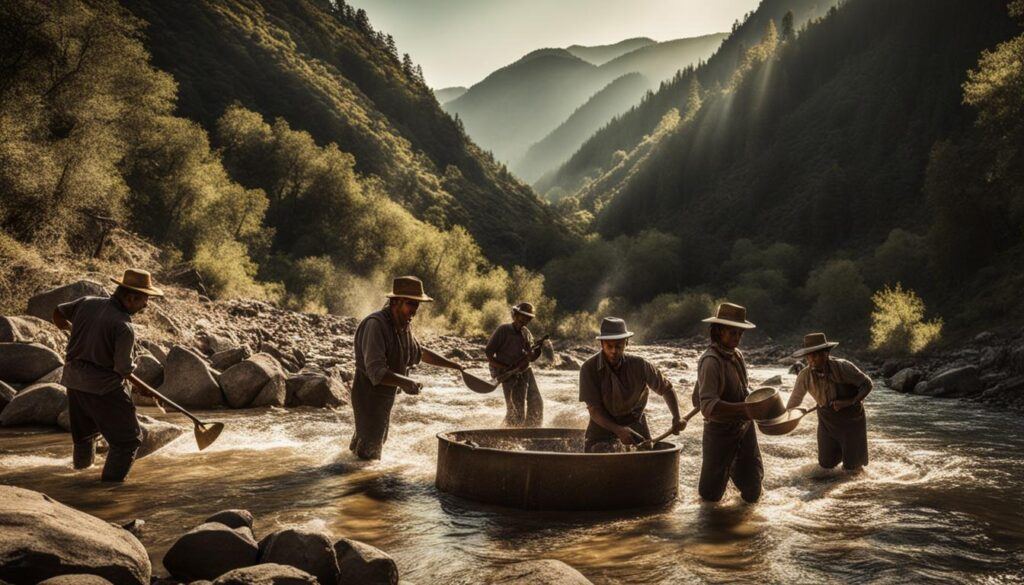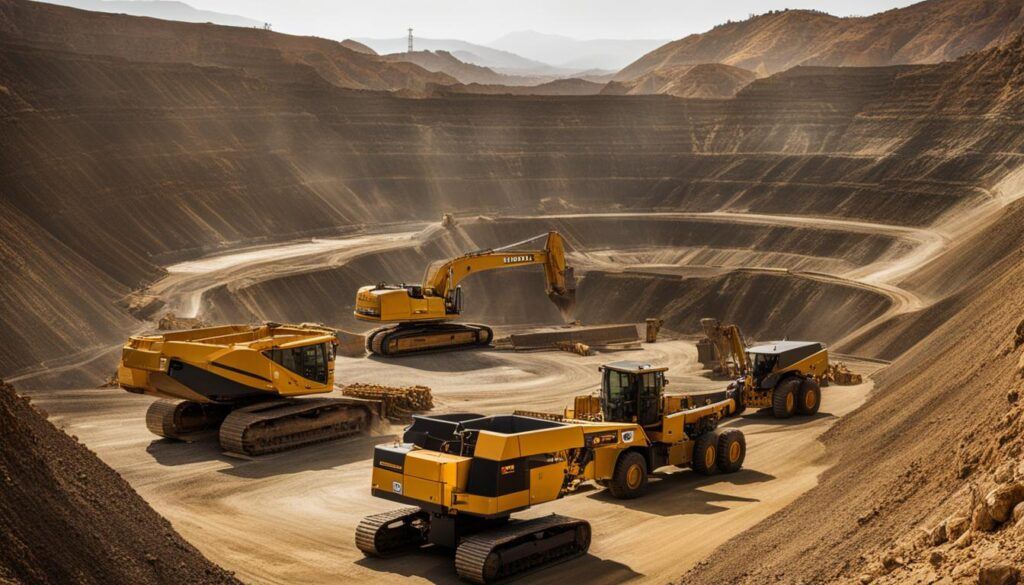California has a rich history of gold mining, with the famous gold rush in the 1800s attracting thousands of fortune seekers. Even today, the allure of finding gold in the Golden State remains strong. But how much gold is actually left in California?
While it’s difficult to determine an exact figure, experts estimate that only a small percentage of the total gold reserves in California have been mined. This means that there is still a significant amount of gold waiting to be discovered and extracted.
Gold mining in California continues to be an active industry, with mining companies exploring and operating mines throughout the state. These operations employ modern mining techniques and equipment to extract gold from underground mines.
So, if you’re wondering whether there is still gold left in California, the answer is a resounding yes. While the easy-to-access gold may have been largely depleted, there are still plenty of unmined gold reserves waiting to be discovered beneath the surface.
Key Takeaways:
- California has significant remaining gold reserves yet to be mined.
- The state’s rich history of gold mining attracts mining companies that continue to explore and extract gold.
- Modern mining techniques and equipment are used to access gold reserves deep underground.
- While the easily accessible gold has been mostly depleted, there are still ample unmined gold reserves in California.
- Gold mining in California remains an active industry that contributes to the state’s economy and global gold production.
The History of Gold Mining in California
The gold rush in California in the mid-1800s was a pivotal moment in the state’s history. Thousands of miners from all over the world flocked to California in search of their fortunes, sparking the infamous California gold rush. This influx of miners led to the discovery of large gold deposits throughout the state.
During the gold rush, two primary methods of gold extraction emerged: placer mining and hard-rock mining. Placer mining involved sifting through sediment in rivers and streams to separate the gold from the surrounding material. This method was relatively simple and accessible, making it a popular choice for individual miners.
Hard-rock mining, on the other hand, required more advanced techniques and equipment. Miners would excavate tunnels and shafts to access gold deposits embedded in solid rock. This method proved to be more challenging and costly, but it allowed for the extraction of gold from deeper and more substantial deposits.
“The discovery of gold in California created immense wealth and transformed the state’s economy.”
The California gold rush brought immense wealth to the state, resulting in the rapid growth and development of its cities and infrastructure. Towns sprang up around mining sites, creating a sense of community and camaraderie among the miners. The economic boom also attracted entrepreneurs and businesses to cater to the needs of the burgeoning population.
While the easily accessible gold in California has been largely extracted, there are still significant gold resources remaining in the state. These remaining deposits may require more advanced mining techniques and technology to access, but they represent a valuable potential source of gold.
Gold Mining Methods in California:
- Placer Mining: Sifting through sediment in rivers and streams to separate gold
- Hard-rock Mining: Excavating tunnels and shafts to access gold deposits embedded in solid rock
Despite the challenges and evolving nature of gold mining in California, the industry remains an essential part of the state’s history and economy. The pursuit of gold continues, with mining companies exploring new technologies and methods to extract the remaining gold resources.

Current Gold Mining Operations in California
Despite the historical significance of gold mining in California, mining operations continue to thrive in the state. Several reputable mining companies are actively involved in gold exploration and operation of mines in different parts of California.
These mining operations employ modern techniques and cutting-edge equipment to extract gold from underground mines. The use of advanced technology allows for more efficient and environmentally sustainable extraction processes, contributing to the overall productivity of the gold mining industry in California.
Gold mining in California not only has a profound impact on the state’s economy but also plays a significant role in the global gold production. The abundance of untapped gold reserves in California makes it a desirable destination for mining companies looking to bolster their gold production.
The Role of Gold Mining Companies in California
“Gold mining companies in California are committed to responsible mining practices and environmental stewardship, ensuring that the benefits of gold extraction are balanced with the preservation of the environment and the well-being of local communities.”
These companies actively engage in gold exploration, locating and assessing potential gold deposits. Through their exploratory efforts, they uncover promising sites that have the potential to yield substantial amounts of gold. Once a viable gold deposit is identified, the mining companies plan and execute the necessary mining operations to extract the precious metal.
The extraction process involves various stages, including drilling, blasting, and tunneling to access the underground mines. Specialized equipment, such as loaders, haul trucks, and crushers, are used to efficiently extract the gold-bearing rock from the underground mines.
Once the gold-bearing rock is extracted, it undergoes further processing to separate the gold from the ore. This typically involves crushing, grinding, and chemical treatment to liberate the gold particles and concentrate them into a form suitable for further refining.
Gold mining operations in California are conducted with a strong focus on safety and adhering to rigorous environmental regulations. Mining companies employ experienced professionals who are well-versed in the best practices for sustainable mining, ensuring minimal impact on the environment.
A Snapshot of Gold Mining Operations in California
| Company Name | Location | Operation Type | Annual Production |
|---|---|---|---|
| Newmont Corporation | Grass Valley Mine | Underground Mining | Estimated 100,000 ounces |
| Kinross Gold Corporation | Round Mountain Mine | Open-pit Mining | Estimated 350,000 ounces |
| Golden Queen Mining Company | Soledad Mountain Mine | Open-pit Mining | Estimated 35,000 ounces |
These are just a few examples of the active gold mining operations in California. Numerous other mining companies contribute to the vibrant gold mining industry in the state, reinforcing its position as an important player in the global gold market.
By leveraging their expertise, technology, and commitment to sustainable practices, these mining companies play a crucial role in tapping into California’s rich gold reserves and sustaining the economic benefits associated with gold mining.

The Environmental Impact of Gold Mining in California
Gold mining, like any other mining activity, has significant environmental impacts. One of the primary concerns associated with gold mining is the generation of mining waste, including waste rock and tailings. These waste materials often contain toxic substances that can pose serious threats to the environment and human health if not properly managed. The accumulation and improper disposal of mining waste can result in water and soil contamination, habitat destruction, and the release of harmful pollutants into the air.
Mining waste, such as waste rock and tailings, can contain high levels of heavy metals and other contaminants that can leach into nearby water sources, impacting aquatic ecosystems and potentially contaminating drinking water supplies. Additionally, the physical displacement and removal of large amounts of earth and vegetation during gold mining operations can disrupt ecosystems and lead to habitat loss for numerous plant and animal species.
To mitigate the environmental impact of gold mining, mining companies are implementing various strategies and technologies. One such technique is known as paste backfilling, where the waste rock and tailings are mixed with a binder to form a paste-like substance. This paste is then used to fill underground mine shafts and other underground voids, reducing the amount of aboveground mine waste that needs to be stored and managed. By utilizing paste backfilling, mining companies can minimize the amount of surface disturbance and reduce the potential for water and soil contamination.
“Efforts are being made by mining companies to mitigate the environmental impact of their operations.”
Furthermore, stringent environmental regulations and monitoring programs are in place to ensure that gold mining activities comply with environmental standards. These regulations govern various aspects of mining operations, including waste management, water usage, and the reclamation and restoration of mining sites after extraction is complete. Mining companies are required to implement proper waste management practices, including the containment and treatment of mining waste to minimize environmental harm. Environmental monitoring programs help to track and assess the impact of mining activities on air quality, water quality, and ecosystem health.
Environmental Concerns
There are a number of environmental concerns associated with gold mining in California. These concerns include:
- Water contamination: The release of toxic substances from mining waste can contaminate water sources, affecting aquatic ecosystems and potentially compromising drinking water supplies.
- Soil degradation: The physical disturbance and removal of soil during mining operations can lead to soil erosion, compaction, and reduced fertility.
- Habitat destruction: The clearing of vegetation and disruption of natural landscapes can result in habitat loss for plant and animal species, leading to reduced biodiversity.
- Air pollution: Dust emissions from mining activities, as well as the release of pollutants during mineral processing, can contribute to air pollution and have adverse effects on air quality.
- Community impacts: Gold mining operations can have social and economic impacts on local communities, including changes in land use, displacement of indigenous communities, and conflicts over resource ownership and distribution.
It is crucial for mining companies to prioritize environmental protection and implement sustainable practices to minimize these concerns and mitigate the environmental impact of gold mining in California.
| Environmental Impact | Concerns |
|---|---|
| Water contamination | Threat to aquatic ecosystems and drinking water supplies |
| Soil degradation | Erosion, compaction, and reduced fertility |
| Habitat destruction | Loss of biodiversity and disruption of natural ecosystems |
| Air pollution | Dust emissions and release of pollutants |
| Community impacts | Social and economic effects on local communities |
Challenges and Costs of Gold Mining in California
Gold mining in California presents several challenges and involves significant costs. The process of extracting gold from the ground can be a costly endeavor, involving various expenses such as labor, equipment, and infrastructure. These costs contribute to the overall economic feasibility of gold mining projects in the state.
One primary challenge in gold mining is the fluctuating cost of mining operations, influenced by factors such as the price of gold itself. When gold prices are low, it may not be economically feasible to mine certain deposits due to the higher costs involved in the extraction process compared to the potential revenue.
Furthermore, accessing gold deposits can be challenging, especially when they are located deep underground or in remote areas. The costs associated with infrastructure development, transportation, and exploration can significantly impact the economic viability of mining projects.
A cost-benefit analysis is crucial for mining companies to assess the financial feasibility of gold mining projects in California. This analysis considers factors such as the estimated gold reserves, anticipated production costs, market trends, and potential profits. By conducting a thorough cost-benefit analysis, mining companies can make informed decisions about the economic viability of mining operations.
| Challenges of Gold Mining in California | Costs of Gold Mining in California |
|---|---|
| – Fluctuating gold prices | – Labor expenses |
| – Difficulty accessing gold deposits | – Equipment costs |
| – Environmental concerns | – Infrastructure development |
| – Regulatory compliance | – Exploration expenses |
“The cost-benefit analysis is crucial for mining companies to assess the financial feasibility of gold mining projects in California.”
The Remaining Gold Reserves in California
Despite the extensive historical mining activity in California, there are still significant gold reserves that have not been mined. Estimates suggest that roughly 63,000 tons of gold are still in the ground in California, compared to the approximately 206,000 tons that have already been mined. These unmined gold deposits are often deeper underground and less accessible, requiring advanced mining techniques and technology to extract.
Gold mining in California has a long and rich history, with the state being home to the famous gold rush in the mid-1800s. During this time, vast amounts of gold were discovered and extracted, leading to a significant boom in the state’s economy. However, even after almost two centuries of mining, a substantial amount of gold still remains unmined in California.
The unmined gold deposits in California are typically found at greater depths, making them more challenging to access. Traditional mining methods may not be sufficient to extract these deposits, necessitating the use of advanced mining techniques such as underground mining and deep drilling. These methods require sophisticated technology and expertise to access the unmined gold reserves and unlock their potential.
Unmined Gold Reserves in California
| Amount of Gold | Unmined | Already Mined |
|---|---|---|
| Tons | 63,000 | 206,000 |
The table above illustrates the stark contrast between the unmined gold reserves and the gold that has already been extracted in California. With over 63,000 tons of gold still waiting to be mined, the state holds considerable potential for future mining operations.
However, accessing these unmined gold deposits poses various challenges. The deeper depths require advanced mining equipment and techniques to extract the gold efficiently. Additionally, environmental concerns and regulations must be considered, as mining operations can have an impact on ecosystems and water resources.
Despite the challenges, the remaining gold reserves in California represent a valuable opportunity for mining companies to tap into a significant source of wealth. With the right technology, expertise, and responsible mining practices, it is possible to unlock the potential of these unmined gold deposits and continue California’s legacy as a prominent gold mining region.

The State of Gold Prices and Demand
The price of gold is influenced by a variety of factors, including supply and demand dynamics and the overall economic conditions. Over time, gold prices have shown fluctuations due to global events such as economic crises and geopolitical tensions. These events can significantly impact the demand for gold and subsequently affect its price.
Currently, the demand for gold remains high, driven by several factors. Gold is often considered a safe-haven asset, meaning that investors turn to it in times of financial uncertainty or market volatility. During economic downturns or geopolitical instability, investors seek the stability and security offered by gold. Additionally, gold is often used as a hedge against inflation, as its value tends to rise when the purchasing power of fiat currencies declines.
With the high demand for gold, the price of this precious metal can experience upward pressure. The delicate balance between supply and demand determines the overall market price for gold. As demand increases, gold mining operations in California and worldwide may become more profitable. Conversely, a decrease in demand could impact the viability of gold mining projects or lead to a decline in gold prices.
Factors Affecting Gold Prices
The price of gold can be influenced by multiple factors, including:
- Economic conditions: Fluctuations in the global economy can impact the demand for gold. During economic downturns, investors often flock to gold as a safe investment, leading to increased demand and higher prices.
- Supply levels: The amount of gold being mined and brought to the market affects its price. If gold mining operations in California and other regions experience challenges or decreased production, it can put upward pressure on gold prices.
- Inflation and currency fluctuations: Gold is often seen as a hedge against inflation and a store of value when fiat currencies lose purchasing power. As inflation rises or currencies weaken, demand for gold can increase, leading to higher prices.
- Geopolitical events: Political and geopolitical instability can influence the demand for gold. During times of uncertainty or conflict, investors may seek the safe-haven qualities of gold, driving up its price.
“Gold prices are intricately tied to global events and economic conditions. The interplay between supply and demand, influenced by economic indicators and geopolitical tensions, shapes the price of gold.”

| Year | Average Gold Price (USD per ounce) |
|---|---|
| 2016 | 1,248 |
| 2017 | 1,258 |
| 2018 | 1,268 |
| 2019 | 1,393 |
| 2020 | 1,769 |
The table above illustrates the average gold price per ounce for select years. It demonstrates the changing nature of gold prices over time, reflecting the impact of various economic and global events.
By analyzing these trends, investors, miners, and industry experts can make informed decisions about when to buy, sell, or invest in gold. Understanding the state of gold prices and demand is crucial for assessing the profitability and viability of gold mining operations in California and elsewhere.
The Future of Gold Mining in California
The future of gold mining in California is influenced by a combination of market conditions, technological advancements, and environmental regulations. As mining companies explore the remaining gold reserves in the state, careful consideration of economic viability and environmental impact is crucial.
With advancing technology, future mining operations in California may involve more efficient and sustainable mining practices. These advancements can help minimize the environmental footprint and enhance resource recovery, ensuring the responsible extraction of the remaining gold reserves.
However, community concerns and opposition to new mining operations must also be taken into account. It is essential for mining companies to engage with local communities and address their concerns regarding environmental impacts, water usage, and land use. Collaboration and transparency are vital for building trust and promoting sustainable mining practices.
“The future of gold mining in California depends on striking a balance between economic development and environmental conservation. By incorporating innovative technologies and addressing community concerns, we can ensure that future mining operations contribute to the prosperity of the state while protecting its natural resources.”
The Future of Gold Mining in California: Key Points
- Market conditions, technological advancements, and environmental regulations shape the future of gold mining in California.
- Advancing technology offers opportunities for more sustainable and efficient mining practices.
- Community concerns and opposition to new mining operations require engagement and transparency from mining companies.
- A balanced approach that considers economic development and environmental conservation is essential for the future of gold mining in California.
| Factors Influencing the Future of Gold Mining in California | Key Considerations |
|---|---|
| Market Conditions | Economic feasibility of gold extraction |
| Technological Advancements | Sustainable and efficient mining practices |
| Environmental Regulations | Compliance with environmental standards and mitigation of impacts |
| Community Concerns | Engagement, transparency, and addressing environmental and social impacts |
Mining Regulations and Environmental Protection
Mining regulations and environmental protection measures are crucial in ensuring responsible mining practices and mitigating the environmental impact of mining activities. In California, mining companies are subject to a comprehensive set of federal, state, and local regulations that govern various aspects of their operations, from waste management to water usage and community engagement. These regulations aim to strike a balance between promoting economic development through mining and preserving the environment for future generations.
The Role of Mining Regulations
Mining regulations provide a framework for managing mining activities and ensure compliance with environmental standards. These regulations dictate the processes and practices that mining companies must follow to protect the environment and prevent or mitigate adverse impacts.
Some key areas covered by mining regulations include:
- Licensing and permitting: Mining companies must obtain the necessary licenses and permits to operate legally. These approvals ensure that the proposed mining activities meet environmental and safety requirements.
- Environmental assessments: Mining projects undergo detailed environmental assessments, evaluating their potential impacts on air quality, water resources, wildlife, and ecosystems. The findings help inform decision-making and identify necessary mitigation measures.
- Waste management: Regulations outline proper waste management practices, including the storage, treatment, and disposal of mining waste. This helps prevent contamination of soil and water and minimizes the release of harmful substances.
- Reclamation: Mining regulations often require companies to develop reclamation plans to restore mined areas to a stable and beneficial condition after mining operations cease. This includes land rehabilitation, habitat restoration, and ensuring long-term environmental sustainability.
Environmental Impact Mitigation
Protecting the environment from mining activities is of utmost importance. Mining companies implement various practices to mitigate their environmental impact and ensure sustainable resource extraction.
“We are committed to minimizing the environmental impact of our mining operations and following all applicable regulations. Protecting the environment is not only a legal requirement but also a moral responsibility.”
Some key environmental impact mitigation measures include:
- Advanced technology and equipment: Mining companies invest in cutting-edge technology and equipment to minimize their environmental footprint. For example, advanced machinery and processes can reduce energy consumption, emissions, and water usage.
- Conservation and biodiversity: Mining companies implement biodiversity conservation programs, protecting sensitive ecosystems and endangered species. They also prioritize the preservation of natural resources such as water and land.
- Community engagement: Engaging with local communities is crucial for addressing environmental concerns and ensuring sustainable mining practices. Mining companies work closely with communities to understand their needs, provide transparency, and implement measures that address community concerns.
By adhering to mining regulations and implementing effective environmental protection measures, mining companies in California strive to minimize their impact on the environment and promote sustainable mining practices that benefit both the industry and the surrounding communities.
The Role of Gold Mining in California’s Economy
Gold mining plays a crucial role in California’s economy, contributing to job creation and generating substantial economic activity. Although the industry may not reach the same scale as during the historic gold rush, it continues to provide employment opportunities and income for individuals and communities.
The economic impact of gold mining extends beyond the mining operations themselves, benefiting supporting industries and services. From equipment suppliers to transportation companies, numerous businesses thrive due to the presence of the gold mining sector.
Let’s take a closer look at the economic benefits that gold mining brings to California:
Job Creation
Gold mining operations require a skilled workforce, creating employment opportunities for a range of professionals and laborers. Engineers, geologists, mining technicians, equipment operators, and maintenance personnel are just a few examples of the diverse job roles supported by the industry. Additionally, supporting businesses such as catering services, security firms, and local suppliers also contribute to job creation.
Economic Activity
The economic impact of gold mining extends far beyond the direct employment it provides. Mining companies invest in infrastructure development, equipment procurement, and technological advancements, stimulating economic activity in the regions where they operate. The income generated by employees and businesses within the industry circulates through the local economy, boosting other sectors such as retail, healthcare, and education.
The prosperity generated by the gold mining industry has a multiplier effect, further strengthening the economy and contributing to overall growth.
While the environmental and social considerations of gold mining are essential, acknowledging the economic benefits is crucial for understanding the industry’s role in California’s economy.
| Key Economic Benefits of Gold Mining in California |
|---|
| Job Creation |
| Economic Activity |
| Infrastructure Development |
| Supporting Industries |
| Income Generation |
Conclusion
In conclusion, gold mining in California remains a significant industry with abundant gold reserves yet to be explored and extracted. Despite the challenges posed by environmental impacts and economic feasibility, the state still holds a substantial amount of gold, making it a valuable resource for the future. The sustainability of gold mining in California relies on a careful balance between market conditions, technological advancements, and environmental considerations.
As market conditions evolve and technology continues to advance, the future of gold mining in California will be shaped by these factors. It is important for mining companies to stay updated on the latest market trends and embrace innovative technologies that can improve the extraction process while minimizing environmental impact. Additionally, environmental considerations will play an integral role in shaping the industry, ensuring that mining operations adhere to strict regulations and focus on sustainable practices.
With the remaining gold reserves in California, there is still ample opportunity for mining companies to contribute to the state’s economy and job creation. The industry’s role in California’s economy extends beyond the mining operations themselves, benefiting numerous supporting industries and services. However, it is crucial for the industry to prioritize responsible mining practices and engage in active community collaboration to address concerns and build a sustainable future for gold mining in the state.
FAQ
How much gold is left in California?
While the exact amount is uncertain, estimates suggest that approximately 63,000 tons of gold are still in the ground in California.
What is the history of gold mining in California?
Gold mining in California has a storied past, with the state’s gold rush in the 1800s attracting thousands of miners in search of their fortune. Large gold deposits were discovered and extracted during this time, transforming California’s economy.
Are there current gold mining operations in California?
Yes, several mining companies are actively exploring and operating gold mines in different parts of California, contributing to the state’s gold production and the global gold supply.
What is the environmental impact of gold mining in California?
Gold mining can have environmental impacts, including the generation of mining waste such as waste rock and tailings. Efforts are being made to mitigate these impacts through responsible mining practices.
What are the challenges and costs of gold mining in California?
Gold mining can be costly, involving expenses such as labor, equipment, and infrastructure. Factors such as low gold prices and the difficulty of accessing gold deposits can also impact the economic feasibility of mining projects.
How much gold is still remaining in California?
Estimates suggest that approximately 63,000 tons of gold are still in the ground in California, compared to the approximately 206,000 tons that have already been mined.
What is the state of gold prices and demand?
Gold prices are influenced by various factors such as supply and demand dynamics and economic conditions. Currently, the demand for gold remains high, driven by its role as a safe-haven asset and a hedge against inflation.
What does the future hold for gold mining in California?
The future of gold mining in California depends on factors such as market conditions, technological advancements, and environmental regulations. Community concerns and opposition may also play a role in shaping the future of the industry.
What are the regulations and protections in place for gold mining in California?
Mining companies in California are subject to federal, state, and local regulations that govern various aspects of mining operations, including waste management, water usage, and community engagement, with the aim of ensuring responsible mining practices and environmental protection.
How does gold mining contribute to California’s economy?
Gold mining in California creates jobs and generates economic activity. It also has ripple effects, benefiting supporting industries and services in the state.



